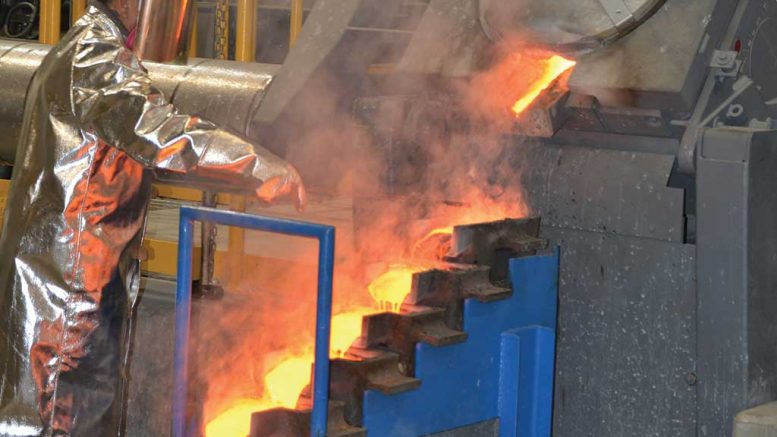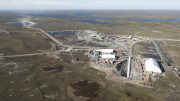The following is an excerpt from the World Gold Council’s new 18-page report, Gold Demand Trends Full Year 2017. View the entire report and more for free at www.gold.org.
Gold demand rallied in the closing months of 2017, gaining 6% year-on-year to 1,095.8 tonnes (35.2 million oz.) in the fourth quarter. But it was too little, too late: full year demand fell by 7% to 4,071.7 tonnes (130.9 million oz.). Exchange-traded-fund inflows, although positive, lagged behind 2016’s stellar growth. Central banks added 371.4 tonnes (11.9 million oz.) to global official gold reserves, 5% down on 2016’s net purchases. Bar and coin demand fell 2% on a sharp drop in U.S. retail investment. India and China led a 4% recovery in jewellery, although demand remains below historical averages.
Increased use of gold in smartphones and vehicles sparked the first year of growth in
technology demand since 2010.
Supply highlights

Global gold supply in 2017 vs 2016. Credit: World Gold Council.
Decline in recycling drove total supply 4% lower to 4,398 tonnes (141.4 million oz.), as mine production crept to new high in 2017. Mine production rose fractionally to 3,268.7 tonnes (105.1 million oz.) in 2017, the highest annual total in our series.
The full year saw net de-hedging of 30.4 tonnes (977,000 oz.), the first year of net de-hedging since 2013.
Unusually high recycling levels in 2016 were the main cause of a 10% year over year decline in 2017, as recycling activity normalized.
Mine production
Mine production finished 2017 by falling 2% year-over-year to 833.1 tonnes in the fourth quarter (26.8 million oz.). This resulted in overall annual mine production of 3,268.7 tonnes (105.1 million oz.) — fractionally higher compared to 2016 — and the highest annual total in our records.

Annual change in global gold mine production (2008-2017). Credit: World Gold Council.
New mine starts in recent years have mostly served to fill the gap left by production losses elsewhere, which has led to a relative plateauing in global output.
Familiar issues in China and Tanzania continued to impact production in the fourth quarter.
In China — the world’s largest producer — the fourth quarter saw another year-over-year decline, with national production dropping 10%. Provisionally, 2017 output is expected to be 9% lower than 2016, only the second annual drop in production since 1980. Stricter environmental regulations — relating to cyanide in tailings — imposed earlier this year resulted in the closing of some marginal operations in 2017, negatively impacting overall output. One of the key messages in President Xi’s report at China’s 19th Communist Party Congress was the implementation of the strictest possible environmental protections.

Material drops off a conveyor at Acacia Mining’s Buzwagi gold mine northwest Tanzania. Credit: Acacia Mining.
Tanzanian mine production fell 15% year-over-year in the fourth quarter. The ongoing concentrate exports ban — introduced in March — continues to impact output from Acacia Mining’s Buzwagi project, while the company is also in the process of reducing operations at its primary Bulyanhulu project to help manage losses.
Several other jurisdictions also saw declines. The year-over-year change in fourth quarter production in the U.S., Brazil and Mali were all affected by comparison with a high base period in 2016.
Output from Russia saw a year-over-year increase in the fourth quarter. The period also saw the start-up of the significant Natalka mine in the Magadan region. The project began commissioning in September and in December poured its first doré. While the project is still in the early stages of production, Polyus expect this will significantly boost the company’s, and Russia’s, production in coming years.
In Indonesia, the mining of higher grade ore at Grasberg — the country’s largest mine — helped boost fourth quarter mine production by 11%. The mining of higher grades is likely to persist into 2018.

Aerial view from the south of TMAC Resources’ Doris gold mine at the Hope Bay gold property in Nunavut. Credit: TMAC Resources.
In Canada, the Hope Bay (first-quarter start-up) and Brucejack (second-quarter start) projects, as well as fourth-quarter start-ups Rainy River and Moose River, contributed to a 5% increase in the fourth quarter.
Several West African start-ups — Fekola and Yanfolila (Mali), and Houndé (Burkino Faso) — also entered production towards the end of 2017.
Net producer hedging
Total net de-hedging in 2017 reached 30.4 tonnes, bringing an end to three consecutive years of modest net hedging. In the fourthquarter, gold miners completed 15 tonnes (482,000 oz.) of net de-hedging; the overall global hedgebook now stands at around 222 tonnes (7.1 million oz.).
As with previous quarters, fresh gold hedges were tactical in nature, mainly established to secure project cashflow, project financing, or high local gold prices.
In October, Westgold Resources announced an increase in its short-term hedgebook of 40,000 oz. to lock in higher local prices. In November, Gold Road — which is developing the Gruyere gold mine in Australia — announced that it had entered into forward agreements which hedged 200,000 oz. to secure a portion of the mine’s future production.
And in the same month, Resolute Mining hedged 72,000 oz. of output, to fund the expansion project at its Ravenswood gold mine. This follows forward sales of 84,000 oz. in September to help fund development of the Syama mine in Mali.





Be the first to comment on "Facts ‘n’ Figures: Gold mine production hit all-time high in 2017, WGC finds"